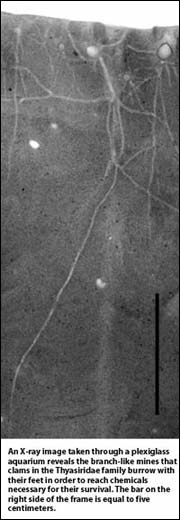Stepping Way Out: Scripps Scientists Watch Clam Feet Elongate Far from the Shell

Scientists at Scripps Institution of Oceanography at the University of California, San Diego, have documented what they are calling possibly the most extreme case of animal structure elongation documented to date.
In a paper published in the November 6 issue of the journal Nature, Suzanne Dufour and Horst Felbeck show that a clam from a certain species can extend its foot (clams have only one foot) up to 30 times the length of its shell to reach chemicals in marine sediment necessary for the survival of their symbionts, marine bacteria that live within the clams.
To test the extension process, Dufour set up aquarium tanks with sediment to investigate how clams that require chemicals differ from those that do not. Clams that live in a symbiotic relationship with marine bacteria act as hosts that retrieve chemicals, typically sulfide or methane.
The Nature paper explains that the symbiotic clams in the Thyasiridae family elongate their feet to burrow extensive mines in an effort to reach the sulfide. X-rays taken through Dufour’s plexiglass tanks over several weeks revealed long, branch-like mines extending through the sediment, especially in cases tested under low sulfide conditions, which forced clams to stretch their feet farther. While they had expected some extension, Dufour says the results were “amazing.” She found clams with shells measuring 4.5 millimeters that had elongated their feet some 13 centimeters from the shell.
“What I find the most interesting about this work is that only the clams with symbionts make these very long burrows,” said Dufour, a graduate student in the marine biology curricular program at Scripps. “The thyasirids in my study that didn’t have symbionts did not make such burrows. To get the sulfide the bacteria need, these clams have evolved the ability to mine the sediment with their feet-it shows that very different species can find amazing ways of cooperating.”
The study was supported by Scripps Institution’s graduate department, the Baxter and Alma Ricard Foundation, and the National Science Foundation.
Scripps Institution of Oceanography at the University of California, San Diego, is one of the oldest, largest, and most important centers for global science research and graduate training in the world. The scientific scope of the institution has grown since its founding in 1903. A century of Scripps science has had an invaluable impact on oceanography, on understanding of the earth, and on society. More than 300 research programs are under way today in a wide range of scientific areas. Scripps operates one of the largest U.S. academic fleets with four oceanographic research ships and one research platform for worldwide exploration. Now plunging boldly into the 21st century, Scripps is celebrating its centennial in 2003.
Media Contact
More Information:
http://scrippsnews.ucsd.edu/article_detail.cfm?article_num=613All latest news from the category: Life Sciences and Chemistry
Articles and reports from the Life Sciences and chemistry area deal with applied and basic research into modern biology, chemistry and human medicine.
Valuable information can be found on a range of life sciences fields including bacteriology, biochemistry, bionics, bioinformatics, biophysics, biotechnology, genetics, geobotany, human biology, marine biology, microbiology, molecular biology, cellular biology, zoology, bioinorganic chemistry, microchemistry and environmental chemistry.
Newest articles

Properties of new materials for microchips
… can now be measured well. Reseachers of Delft University of Technology demonstrated measuring performance properties of ultrathin silicon membranes. Making ever smaller and more powerful chips requires new ultrathin…

Floating solar’s potential
… to support sustainable development by addressing climate, water, and energy goals holistically. A new study published this week in Nature Energy raises the potential for floating solar photovoltaics (FPV)…

Skyrmions move at record speeds
… a step towards the computing of the future. An international research team led by scientists from the CNRS1 has discovered that the magnetic nanobubbles2 known as skyrmions can be…





















